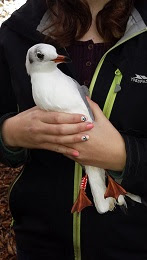It seemed the spirit of Halloween was lingering, as a spooky, thick fog obscured all but the closest trees and the river. There was no wind and the dangling leaves of the willows trailed in the smooth flowing water like fingertips creating miniature ripples and whirlpools. Out of the white gloom came a brilliant flash of blue as a kingfisher shot down river and up into the lower branches of the willow, watching and waiting. The other birds of the river continue with their morning rituals, although it is already comparatively late in the day for them with the sun having been up for a few hours already. Ducks meander just past the old road bridge on whose worn stone you can still see the scars from tanks. Canada Geese preen themselves or feed on the grassy banks oblivious to the occasional car that appears briefly from the gloom. Overhead the harsh call of Carrion Crows and the cackle of Jackdaws echoes through the fog. Moorhens emerge from the reeds and sedge along the river’s edge with their characteristic bobbing head, circle a few times then disappear again. A family of Mute Swans, the two young still greyish brown, slowly patrol this small stretch of river. From the shrouded trees comes the twittering calls of various tits, Robins and Blackbirds, all heard but not seen.
 |
| Black-headed Gull (winter plumage) |
Across the dark water stretches a footbridge, the clattering of puppy paws and footsteps its usual fare. But today it has a mist net covering its length, rising high above its barrier. The lure of food brings the ducks, swans and even the Moorhens closer to this bridge, and with them come the Black-headed Gulls. Brilliant white underneath, with silvery grey backs and bright orangey red legs and bill, they bounce effortlessly through the air like ghosts. Their heads are essentially white, with just a smudge of black behind a bright, black eye. Twisting and turning they spy the provisions, dropping down to pick at it from the water’s surface, watching as what is not gobbled by duck, goose or swan floats down river and under the bridge. The gulls flick up and over the bridge and one falls into the trap. The large mesh net is adept at holding the larger, longer winged gull until it is removed by experienced hands.
And so there it is, in the hand, a small elegant Black-headed Gull. All ready for a metal ring, and in this case a colour ring to add to the project looking at gull movement from the region. We know birds are often moving between the UK and the continent especially Denmark and The Netherlands. But individuals have been found further afield including Senegal and Mauritania. So where will this bird go? Who knows but it will be easier for someone to report it since it has a colour ring which means it can be identified without being re-caught.
It does not take long to process the bird. Unlike some of the larger gulls that take a number of years to replace all their juvenile feathers and look adult, Black-headed Gulls are will attain adult plumage when they are just over one year old. So at this time of year, there will either be first-winter birds (so birds hatched this summer) or adult winter birds. And so with that, and its colour ring, the bird is weighed and measured and then released quickly disappearing into the smokey fog.
 |
| Ringed and colour ringed |
It does not take long to process the bird. Unlike some of the larger gulls that take a number of years to replace all their juvenile feathers and look adult, Black-headed Gulls are will attain adult plumage when they are just over one year old. So at this time of year, there will either be first-winter birds (so birds hatched this summer) or adult winter birds. And so with that, and its colour ring, the bird is weighed and measured and then released quickly disappearing into the smokey fog.
Hi Rachael! Funnily enough I was entering a load of data on Black-headed Gulls as a message about your blog post popped up! That's a handy way of catching them. "Our" gulls I'm analysing are all colour ringed as "teenage" chicks on the same tiny island on a gravel pit lake near Reading, but they disperse far and wide - to France, Ireland and even Milton Keynes ;-)
ReplyDeleteBest wishes, Liz